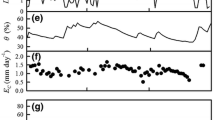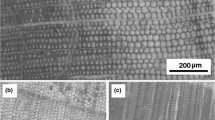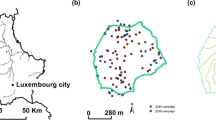Abstract
The assessment of forest transpiration rates is crucial for determining plant-available soil water consumption and drought risk of trees. Xylem sap flux measurements have been used increasingly to quantify stand transpiration in forest ecosystems. Here, we compare this empirical approach with hydrological modeling on the basis of a stand transpiration dataset of adult beech (Fagus sylvatica), which was acquired across Bavaria, Germany, at eight forest sites. Xylem sap flux sensors were installed in five dominant trees each. Two tree to stand upscaling approaches, related to site-specific (1) sapwood area or (2) to leaf area index, were compared. The outcome was examined each in relation to process-based stand hydrological modeling, using LWF-BROOK90. Distinct relationships between tree diameter at breast height (1.30 m) and sapwood area-weighted sap flux along the radial profile became apparent across the study sites, confirming a generic allometric basis for stand-level upscaling of transpiration. The two upscaling approaches did not differ in outcome, representatively covering stand structure for comparison with modeling. Differential analysis yielded high agreement between the empirical and modeling approaches throughout most of the study period, although LWF-BROOK90 tended to overestimate sap flux measurements under low soil moisture. The two empirical approaches proved reliable for even-aged beech stands, as performance under high stand-structural heterogeneity awaits clarification. Findings advance stand-level hydrological modeling regarding coverage of stomatal behavior during temporary limitation in water availability.








Similar content being viewed by others
Abbreviations
- DBH:
-
Diameter at breast height
- POD:
-
Phytotoxic ozone dose
- PLA:
-
Projected leaf area
- LAIseasonal :
-
Modeled seasonally changing projected leaf area index
- swafw :
-
Flux-weighted sapwood area
- Δw :
-
Leaf air mol fraction difference of water vapor
- P aw :
-
Plant-available soil water
References
Adelmann JD, Ewers BE, Mackay DS (2008) Use of temporal patterns in vapour pressure deficit to explain spatial autocorrelation dynamics in tree transpiration. Tree Physiol 28:647–658
Assmann E (1961) Waldertragskunde. BLV, München 490
Bay StMELF (1990) Hilfstafeln für dieForsteinrichtung, Zusammengestelltfür den Gebrauch in der Bayerischen Staatsforstverwaltung, Auflage 1990, Hrsg. Bayerisches Staatsministerium für Ernährung, Landwirtschaft und Forsten (Bay StMELF)
Beudert B, Breit W (2004) Zwölf Jahre Integrated- Monitoring-Programm an der Meßstelle Forellenbach im Nationalpark Bayerischer Wald. Fkz. 351 01 012; Nationalparkverwaltung Bayerischer Wald, 307 S Grafenau
Beudert B, Breit W, Höcker L, Stamm O, Schwarz B (2007) Integrierte Umweltbeobachtung im Forellenbachgebiet des Nationalparks Bayerischer Wald im Netzwerk de Internationalen Kooperationsprogramms über die Auswirkungen grenzüberschreitender Luftschadstoffe und des Klimawandels auf Ökosysteme (UN/ECE—ICP Integrated Monitoring), Hrsg. Umweltbundesamt (UBA), Nationalpark Bayerischer Wald
Bittner S, Talkner U, Krämer I, Beese F, Dirk HD, Priesack E (2010) Modeling stand water budgets of mixed temperate broad-leaved forest stands by considering variations in species-specific drought response. Agric For Meteorol 150:1347–1357
Bittner S, Legner N, Beese F, Priesack E (2012) Individual tree branch-level simulation of light attenuation and water flow of three F. sylvatica L. trees. J Geophys. doi:10.1029/2011JG001780
BMELF(1997) Dauerbeobachtungsfläche zur Umweltkontrolle im Wald Level II. Erste Ergebnisse. Hrsg. Bundesministerium für Ernährung, Landwirtschaft und Forsten
Burger H (1950) Holz, Blattmenge und Zuwachs-Die Buche. In: Burger H (Hrsg.) Mitteilungen der Schweizerischen Anstalt für das Forstliche Versuchswesen. Kommissionsverlag von Beer & CIE, Zürich; Band 26, 2. Heft, pp 419–468
Busch SE, Hultine RH, Sperry JS, Ehelinger JR (2010) Calibration of thermal dissipation sap flow probes from ring- and diffuse-porous trees. Tree Physiol 30(12):1545–1554
Cermak J, Cienciala E, Kucera J, Hällgren J-E (1992) Radial velocity profiles of water flow in trunks of Norway spruce and oak and the response of spruce to severing. Tree Physiol 10:367–380
Cermak J, Cienciala E, Kucera J, Lindroth A, Bednarrova E (1995) Individual variation of sap flow rate in large pine and spruce trees and stand transpiration: a pilot study at the central NOPEX site. J Hydrol 168:17–27
Domec J-C, King JS, Noormets A, Sun G, McNulty SG, Gavazzi M, Treasure E (2010) Hydraulic redistribution of soil water by roots affects whole stand evapotranspiration and net ecosystem carbon exchange. New Phythol 187:171–183
Domec J, Sun G, Noormets A, Gavazzi MJ, Treasure EA, Cohen E, Swenson JJ, McNulty SG, King JS (2012) A comparison of three methods to estimate evapotranspiration in two contrasting loblolly pine plantations: age-related changes in water use and drought sensitivity of evapotranspiration components. For Sci 58(5):497–512
Ellenberg H, Leuschner C (2010) Vegetation Mitteleuropas mit den Alpen: in ökologischer, dynamischer und historischer Sicht, 6. Auflage, UTB, Stuttgart, 1357 S
Fassnacht KS, Gower ST, Normann JM, McMurtie RE (1994) A comparison of optical and direct methods for estimationg foliage surface area index in forests. Agric For Meteorol 71:183–2007
Federer CA (2002) BROOK 90: a simulation model for evaporation, soil water, and streamflow. http://www.ecoshift.net/brook/brook90.htm
Federer CA, Vörösmarty C, Fekete B (1996) Intercomparison of methods for calculating potential evaporation in regional and global water balance models. Water Resour Res 32:2315–2321
Federer CA, Vörösmarty C, Fekete B (2003) Sensitivity of annual evaporation to soil and root properties in two models of contrasting complexity. J Hydrometeorol 4:1276–1290
Fiora A, Cescatti A (2006) Diurnal and seasonal variability in radial distribution of sap flux density: implications for estimation stand transpiration. Tree Physiol 26:1217–1225
Ford CR, Goranson CE, Mitchell RJ, Will RE, Teskey RO (2004a) Diurnal and seasonal variability in the radial distribution of sap flow: predicting total stem fow in Pinus taeda trees. Tree Physiol 24:951–960
Ford CR, McGuire MA, Mitchell RJ, Teskey RO (2004b) Assessing variation in the radial profile of sap flux density in Pinus species and its effect on daily water use. Tree Physiol 24:241–249
Gebauer T, Horna V, Leuschner C (2008a) Variability in radial sap flux density patterns and sapwood area among seven co-occurring temperate broad-leaved tree species. Tree Physiol 28(12):1821–1830
Gebauer T, Horna V, Leuschner C (2008b) Variability in radial sap flux density patterns and sapwood area among seven co-occurring temperate broad-leaved tree species. Tree Physiol 28:1821–1830
Gebauer T, Horna V, Leuschner C (2012) Canopy transpiration of pure and mixed forest stands with variable abundance of European beech. J Hydrol:2–14. doi:10.1016/j.jhydrol.2012.03.009
Gebhardt T, Grams T, Häberle K-H, Matyssek R, Schulz C, Grimmeisen W, Ammer C (2012) Helfen Durchforstungen bei Trockenheit? Erste Ergebnisse eines Versuchs zur Verbesserung der Wasserversorgung junger Fichtenbestände. LWF aktuell 87:8–10
Granier A (1985) Une nouvelle methode pour la mesure du flux de seve brute dans le tronc des arbres. Ann Sci For 42:81–88
Granier A (1987) Evaluation of transpiration in a Douglas-fir stand by means of sap flow measurements. Tree Physiol 3:309–320
Granier A, Breda N (1996) Modelling canopy conductance and stand transpiration of an oak forest from sap flow measurements. Ann Sci For 53:115–122
Granier A, Biron P, Köstner B, Gay LW, Najjar G (1996) Comparisons of xylem sap flow and water vapour flux at the stand level and derivation of canopy conductance for Scots pine. Theor Appl Climatol 53:115–122
Granier A, Biron P, Lemoine D (2000) Water balance, transpiration and canopy conductance in two beech stands. Agric For Meteorol 100:291–308
Grote R, Reiter IM (2004) Competition-dependent modelling of foliage biomass in forest stands. Trees 18:596–607
Grote R (2002) Von der Baumdimension zur Biomasse und wieder zurück—Ein neuer Ansatz zur dynamischen Modellierung von Baum-und Bestandesbiomassen, In Forstliche Forschungsberichte München: Inventur von Biomasse-und Nährstoffvorräten in Waldbeständen, Nr. 186
Hammel K, Kennel M (2001) Charakterisierung und Analyse der Wasserverfügbarkeit und des Wasserhaushalts von Waldstandorten in Bayern mit dem Simulationsmodell BROOK). Forstliche Forschungsberichte München. Heft 185
Hatton TJ, Wu H (1995) Scaling theory to extrapolate individual tree water use to stand water use. Hydrol Process 9:527–540
ICP Forest (2006) Manual on methods and criteria for harmonized sampling, assessment, monitoring and analysis of the effects of air pollution on forests. UNECE, ICP Forests, Hamburg. ISBN: 978-3-926301-03-1. (http://www.icp-forests.org/Manual.htm)
Köstner B, Biron P, Siegwolf R, Granier A (1996a) Estimates of water vapor flux and canopy conductance of Scots pine at the tree level utilizing different xylem sap flow methods. Theor Appl Climatol 53(1–3):105–1148
Köstner B, Alheimer M, Tenhunen JD (1996b) Tree canopy transpiration at different sites of spruce forest ecosystem. Verhandlungen der Gesellschaft für Ökologie. Band 26:61–66
Köstner B, Falge EM, Alsheimer M, Geyer R, Tenhunen JD (1998a) Estimating tree canopy water use via xylem sapflow in an old Norway spruce forest and a comparison with simulation-based canopy transpiration estimates. Ann Sci For 55:125–139
Köstner B, Granier A, Cermak J (1998b) Sap flow measurements in forest stands: methods and uncertainties. Ann Sci For 55:13–27
Köstner B, Matyssek R, Heilmeier H, Clausnitzer F, Nunn AJ, Wieser G (2008) Sap flow measurements as a basis for assessing trace-gas exchange of trees. Flora 203:14–33
Kraft G (1884) Durchforstungen, Schlagstellungen und Lichtungshieben. Klindworth’s Verlag, Hannover
Kume T, Tsuruta K, Komatsu H, Kumgai TO, Higashi N, Shinohara Y, Otsuki K (2009) Effects of sample size on sap flux-based stand scale transpiration estimates. Tree Physiol 30:129–138
Lu P, Urban L, Ping Z (2004) Granier’s Thermal dissipation Probe (TDP) Method for Measuring Sap Föow in Trees: Theora nad Pactice. Acta Botanica Sinensis 46(6):631–646
Lütschwager D, Remus R (2007) Radial distribution of sap flow density in trunks of a mature beech stand. Ann For Sci 64:431–438
Lüttge U, Kluge M, Bauer G (1999) Botanik. Weinheim Wiley-VCH 1999. 3. Auflage, 625 Seiten ISBN/EAN: 978-3-527-30099-0
Matyssek R, Bytnerowicz A, Karlsson P-E, Paoletti E, Sanz M, Schaub M, Wieser G (2007) Promoting the O3 flux concept for European forest trees. Environ Pollut 146:587–607
Matyssek R, Wieser G, Patzner K, Blaschke H, Häberle K-H (2009) Transpiration of forest trees and stands at different altitude: consistencies rather than contrasts? Eur J For Res 128:579–596
Matyssek R, Karnosky DF, Wieser G, Percy K, Oksnen E, Grams TEE, KubiskeE M, Hanke D, Pretzsch H (2010) Advances in understanding ozone impact on forest trees: messages from novel phytotron and free-air fumigation studies. Environ Pollut 158(6):1990–2006
Meiresonne L, Nadezhdin N, Cermak J, Van Slycken J, Ceulemans R (1999) Measured sap flow and sinulated transpiration from a poplar stand in Flanders (Belggium). Agric For Meteorol 96:165–179
Menzel A (1997) Phänologie von Waldbäumen unter sich ändernden Klimabedingungen—Auswertung der Gärten und Möglichkeiten der Modellierung von Beobachtungen in den Internationalen Phänologischen Phänodaten. Forstliche Forschungsberichte München164, 147 S
Monteith JL (1981) Evaporation and surface temperature. Q J Royal Meteorol Soc 107:1–27
Nunn AJ, Wieser G, Metzger U, Löw M, Wipfler P, Häberle K-H, Matyssek R (2007) Exemplifying whole-plant ozone uptake in adult forest trees of contrasting species and site conditions. Environ Pollut 146:629–639
Oren R, Pataki DE (2001) Transpiration in response to variation in microclimate and soil moisture in southeastern deciduous forests. Oecologia 127(4):549–559
Oren R, Ewers BE, Todd B, Phillips N, Katul G (1998a) Water balance delineates the soil layer in which moisture affects canopy conductance. Ecol Appl 8:990–1002
Oren R, Phillips N, Katul G, Ewers BE, Pataki DE (1998b) Scaling xylem sap flux and soil water balance and calculating variance: a method for partitioning water flux in forests. Ann Sci For 55:191–216
Poyatos R, Cermak J, Llorsen P (2007) Variation in radial patterns of sap flux in pubescent oak (Quercus pubescens) and its implications for tree and stand transpiration measurements. Tree Physiol 27:537–548
Pretzsch H, Kahn M, Grote R (1998) Die Fichten-Buchen-Mischbestände des Sonderforschungsbereiches “Wachstum oder Parasitenabwehr?” im Kranzberger Forst. Forstw. Cbl. 117:241–257
Rautio P, Fürst A, Stefan K, Raitio H, Bartl U (2010) Sampling and analysis of needles and leaves. Manual Part XII. In: Manual on methods and criteria for harmonized sampling, assessment, monitoring and analysis of the effects of air pollution on forests, UNECE, ICP Forests Programme Co-ordinating Centre, Hamburg, p 19. ISBN: 978-3-926301-03-1. (http://www.icp-forests.org/Manual.htm)
Reiter IM, Häberle K-H, Nunn AJ, Heerdt C, Reitmayer H, Grote R, Matyssek R (2005) Competitive strategies in adult beech and spruce: space-related foliar carbon investment versus carbon gain. Oecologia 146:337–349
Richardson JJ, Moskal LM, Kim S-H (2009) Modeling approaches to estimate effective leaf area index from aerial discrete-return LIDAR. Agric For Meteorol 149(6–7):1152–1160
Sevanto S, Nikinmaa E, Riikonen A, Daley M, Pettijohn JC, Mikkelsen TN, Philips N, Holbrook NM (2008) Linking xylem diameter variations with sap flow measurements. Plant Soil 305:77–90
Shinozaki K, Yoda K, Hozumi K, Kira T (1964) A quantitative analysis of plant form. The pipe model theory II. Further evidence of the theory and its application in forest ecology. Jpn Ecol 14:133–139
Shuttleworth JW, Wallace JS (1985) Evaporation from sparse crops: an energy combination theory. Q J Royal Meteorol Soc 111:839–855
Smolander H, Steinberg P (1996) Response of LAI-2000 estimates to changes in plant surface area index in a Scots pine stand. Tree Physiol 16:345–349
Steppe K, De Pauw DJW, Doody TM, Teskey RO (2010) A comparison of sap flux density using thermal dissipation, heat pulse velocity and heat field deformation methods. Agric For Meteorol 150:1046–1056
Traver E, Ewers BE, Macky DS, Loranty MM (2009) Tree transpiration varies spatially in response to atmospheric but not edaphic conditions. Funct Ecol 24:273–282
Van Genuchten MT (1980) A closed-form equation for predicting the hydraulic conductivity of unsaturated soils. Soil Sci Soc Am J 44:892–898
Vertessy RA, Benyon RG, O’Sullivan SK (1995) Relationships between stem diameter, sap wood area, leaf area and transpiration in a young mountain ash forest. Tree Physiol 15:559–567
Wagner A (2010) The FutMon water budget model comparison action FutMon C1-Met-29 (BY) Report
Warren JM, Meinzer FC, Brooks JR, Domec JC (2005) Vertical stratification of soil water storage and release dynamics in Pacific Northwest coniferous forests. Agric For Meteorol 130:39–58
Warren JM, Meinzer FC, Brooks JR, Domec JC, Coulombe R (2007) Hydraulic redistribution of soil water in two old-growth coniferous forests. New Phythol 173(4):753–765
Weis W, Hertel C, Wagner A, Raspe S (2011) Abschlussbericht ST 241 Verbesserung der Wasserhaushaltsmodellierung mit Daten des forstlichen Umweltmonitorings im Projekt FUTMON (LIFE+)
Weiss M, Baret F, Smith GJ, Jonckheere I, Coppin P (2004) Review of methods for in situ leaf area index (LAI) determination part II. Estimation of LAI, errors and sampling. Agric For Meteorol 121:37–53
Wieser G, Matyssek RR, Köstner B, Oberhuber W (2003) Quantifying ozone uptake at the canopy level of spruce, pine and larch trees at the alpine timberline: an approach based on sap flow measurement. Environ Pollut 126(1):5–8
Wieser G, Matyssek R, Cieslek S (2008) Upscaling ozone flux in forests from leaf to landscape. Zeitschrift Ital J Agron 1:35–41
Wilson KB, Hanson PJ, Mulholland PJ, Baldocchi DD, Wulschleger SD (2001) A comparison of methods for determining forest evapotranspiration and its components: sap-flow, soil water budget, eddy covariance and catchment water balance. Agric For Meteorol 106(2001):153–168
Wullschleger SD, King AW (2000) Radial variation in sap velocity as a function of stem diameter and sapwood thickness in yellow-poplar trees. Tree Physiol 20(8):511–518
Wullschleger SD, Meinzer FC, Vertessy RA (1998) A review of whole-plant water use studies in tree. Tree Physiol 18(8–9):499–512
Acknowledgments
We want to thank Stephan Raspe, Lothar Zimmermann, Hans-Peter Dietrich, Winfried Grimmeisen and Ernst Bickel from the Bavarian State Institute of Forestry (LWF) for courtesy of meteorological, soil water and biometric data from Level II sites, and Jochen Krause and Christoph Happe-Wagner for technical support, Burkhard Beudert and Willi Breit from the Bavarian Forest National Park for courtesy of meteorological soil water and biometric data from Forellenbach and technical support, Jochen Dieler from the Chair of forest growth (TUM) for courtesy of biometric data of the Kranzberg Forest, and the Deutscher Wetterdienst DWD, the Bayerische Landesanstalt für Umwelt LFU and the Hessische Landesanstalt für Umwelt und Geologie HLUG for providing meteorological data. The funding for this study was kindly provided by the Bayerisches Staatsministerium für Ernährung, Landwirtschaft und Forsten—Bavarian Ministry for Nutrition, Agriculture, and Forestry (Bay. StMELF) as part of the KLIP program.
Author information
Authors and Affiliations
Corresponding author
Additional information
Communicated by A. Merino.
This article originates from the IUFRO Conference “Biological Reactions of Forests to Climate Change and Air Pollution,” held in Kaunas/ Lithuania during May 18–27, 2012, as organized by IUFRO Research Group 7.01.00 in cooperation with COST Action FP 0903 “MAFor,” North American Air Pollution workshop ENVeurope and ICP monitoring task force (local organizer: Algirdas Augustaitis).
Rights and permissions
About this article
Cite this article
Baumgarten, M., Weis, W., Kühn, A. et al. Forest transpiration—targeted through xylem sap flux assessment versus hydrological modeling. Eur J Forest Res 133, 677–690 (2014). https://doi.org/10.1007/s10342-014-0796-4
Received:
Revised:
Accepted:
Published:
Issue Date:
DOI: https://doi.org/10.1007/s10342-014-0796-4




